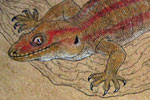The purported Yeti, an ape-like creature that walks upright and roams the remote Himalayas, may in fact be an ancient polar bear species, according to new DNA research by Bryan Sykes with Oxford University. Sykes subjected two hairs from what locals say belonged to the elusive Yeti only to discover that the genetics matched a polar bear jawbone found in Svalbard, Norway dating from around 120,000 (though as recent as 40,000 years ago).
“I don’t think it means there are ancient polar bears wandering around the Himalayas,” Sykes told the Independent. “It could mean there is a subspecies of brown bear in the high Himalayas descended from the bear that was the ancestor of the polar bear. Or it could mean there has been more recent hybridization between the brown bear and the descendent of the ancient polar bear.”
Polar bears (Ursus maritimus) may have separated from brown bears (Ursus arctos) as recently as 150,000 years ago, but more recent research argues for a longer evolution, around 4-5 million years ago. Hybridization remains possible between the two species, and is currently a threat to polar bears as their climate heats up from global warming melting the ice the bears depend on.
The theory that the Yeti is in fact an unknown bear is not a new one. In his searches for the Yeti, mountaineer Reinhold Messner found a reference to the Yeti in a 300-year-old Tibetan manuscript that described it as a type of bear.
 Artist’s rendition of the Yeti. Illustration by: Philippe Semeria/Creative Commons 3.0. |
However, Sykes’ DNA analysis is the first to undercover hard proof. The two tested hairs came from over 1,285 kilometers (800 miles) apart, one from India and the other from Bhutan; the Indian hair is reportedly from an animal killed 40 years ago, while the hair from Bhutan was discovered just ten years ago. The region is already home to one distinct bear: the Himalayan brown bear (Ursus arctos isabellinus).
Sykes’ research has not yet been published in a peer-reviewed journal, and other scientists have showed some skepticism.
Bill Amos, a research with the University of Cambridge, told the Guardian that it really depends on whether or not the hairs came from a “Yeti” or if the hair was taken deliberately from a polar bear as a Yeti-inspired hoax.
“From Brian Sykes back to the hair is fine. Where the hair comes from and how it got there, I would be more skeptical about,” Amos said, noting that it was also difficult to imagine how these bears could stay hidden into the Twenty First Century.
“If there was anything like a medium population of 20-50, which is the minimum number that most people think would allow a viable population, why aren’t these things being seen more often by people out looking for snow leopard pelts and all the rest of it? There is very little these days that is so remote that you don’t get actually appreciable numbers of humans with binoculars out there.”
Dozens of new mammals are discovered every year by researchers, but these are most often rodents and bats. The last new large-bodied mammal discovered by scientists was the soala (Pseudoryx nghetinhensis) in 1992, found in the dense, remote rainforests of of the Annamite Mountains in Southeast Asia. Not surprisingly, new mammal discoveries today are almost solely the province of the tropics.
However, to confirm Sykes’s findings, the next step would be for intrepid biologists to attempt to discover the elusive bears and determine exactly what they are—new species or subspecies, hybridization, or something else.
“I think this bear, which nobody has seen alive… may still be there and may have quite a lot of polar bear in it,” Sykes told the BBC, adding that if it is a brown bear-polar hybrid it may display unusual behaviors as “eyewitnesses report.”
“Then I think that may well be the source of the mystery and the source of the legend,” he concludes.
However, Sykes, who has also been studying alleged bigfoot hairs, doesn’t say that all the hairs tested were from bears. In 2008, scientists analyzing other Yeti hair discovered it had actually come from a Himalayan goral, an ungulate (hoofed animal) related to both antelope and goats.
“Bigfootologists and other enthusiasts seem to think that they’ve been rejected by science. Science doesn’t accept or reject anything, all it does is examine the evidence and that is what I’m doing,” Sykes said.
Sykes’ findings will be the subject of a three-part documentary in the UK. In addition, he has a book coming out on the subject next year: The Yeti Enigma: A DNA Detective Story.

Polar bear in Alaska. Polar bears are the world’s largest land carnivore. Photo by: Alan Wilson/Creative Commons 3.0.
Related articles
California ‘sea monster’ is an oarfish
(10/16/2013) The dead “sea monster’ spotted off the coast of Southern California on Sunday is actually an oarfish, a deepwater fish species that can reach a length of 55 feet (17 meters).
Could the Tasmanian tiger be hiding out in New Guinea?

(05/20/2013) Many people still believe the Tasmanian tiger (Thylacinus cynocephalus) survives in the wilds of Tasmania, even though the species was declared extinct over eighty years ago. Sightings and reports of the elusive carnivorous marsupial, which was the top predator on the island, pop-up almost as frequently as those of Bigfoot in North America, but to date no definitive evidence has emerged of its survival. Yet, a noted cryptozoologist (one who searches for hidden animals), Dr. Karl Shuker, wrote recently that tiger hunters should perhaps turn their attention to a different island: New Guinea.
Genetics study claims to prove existence of Bigfoot

(02/13/2013) A new study purporting to uncover DNA evidence for Bigfoot has been published today in DeNovo Scientific Journal. While Bigfoot-enthusiasts have long argued that the cryptic monster is an unidentified ape species, the new study says their genetic evidence shows the Sasquatch is in fact a hybrid of modern human females mating with an unidentified primate species 13,000 years ago. The only problem: the journal in which the study is published—DeNovo Scientific Journal—appears to have been created recently with the sole purpose to publish this study.
Bloodsucking flies help scientists identify rare, hard-to-find mammals

(01/16/2013) Last year scientists released a study that is likely to revolutionize how conservationists track elusive species. Researchers extracted the recently sucked blood of terrestrial leeches in Vietnam’s remote Annamite Mountains and looked at the DNA of what they’d been feeding on: remarkably researchers were able to identify a number of endangered and rarely-seen mammals. In fact two of the species gleaned from these blood-meals had been discovered by scientists as late as the 1990s. In the past, trying to find rare and shy jungle animals required many man hours and a lot of funding. While the increasing use of remote camera traps has allowed scientists to expand their search, DNA sampling from leeches could be the next big step in simplifying (and cheapening) the quest for tracking the world’s mammals.
Traditional belief in mythical beasts help protect forests
(06/19/2012) Cultural practices including beliefs in mythical beasts and animals that dance have helped maintain forests in the West African country of the Gambia and Malaysian Borneo, said a researcher from Oxford University speaking at the annual meeting of the Association for Tropical Biology and Conservation in Bonito, Brazil.
Does the Tasmanian tiger exist? Is the saola extinct? Ask the leeches
(04/30/2012) The use of remote camera traps, which photograph animals as they pass, has revolutionized research on endangered and cryptic species. The tool has even allowed scientists to document animals new to science or feared extinct. But as important as camera traps have become, they are still prohibitively expensive for many conservationists and require many grueling hours in remote forests. A new paper in Current Biology, however, announces an incredibly innovative and cheaper way of recording rare mammals: seek out the leeches that feed on them. The research found that the presence of mammals, at least, can be determined by testing the victim’s blood for DNA stored in the leech.
Beyond Bigfoot: the science of cryptozoology

(03/26/2012) Anyone who doubts cryptozoology, which in Greek means the “study of hidden animals,” should remember the many lessons of the past 110 years: the mountain gorilla (discovered in 1902), the colossal squid (discovered in 1925, but a full specimen not caught until 1981), and the saola (discovered in 1992) to name a few. Every year, almost 20,000 new species are described by the world’s scientists, and a new book by Dr. Karl Shuker, The Encycloapedia of New and Rediscovered Animals, highlights some of the most incredible and notable new animals uncovered during the past century.